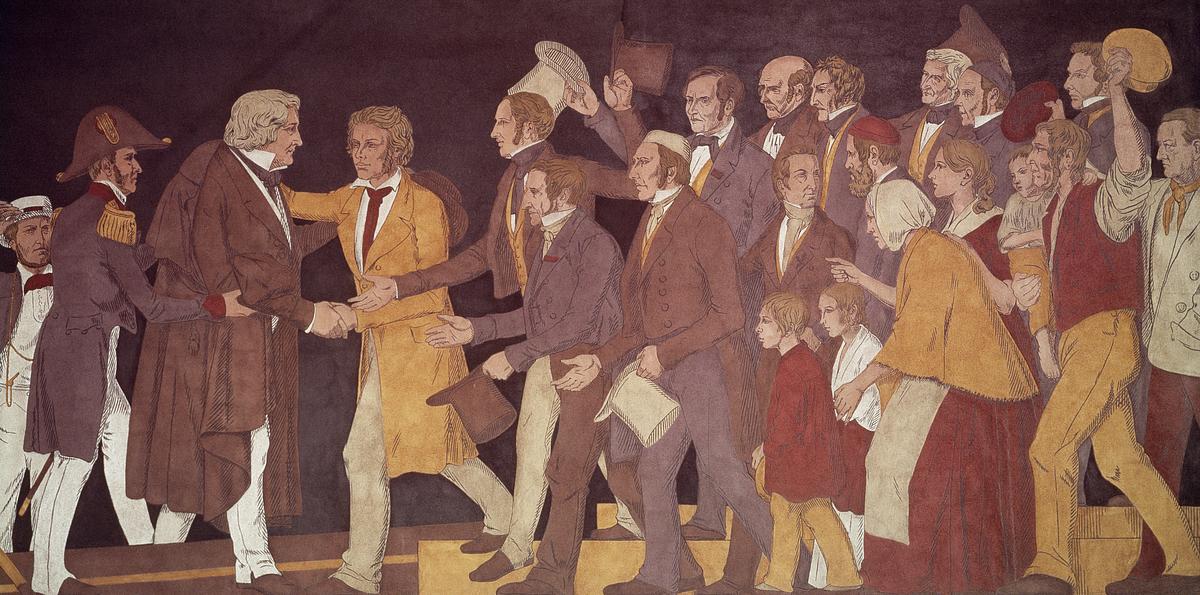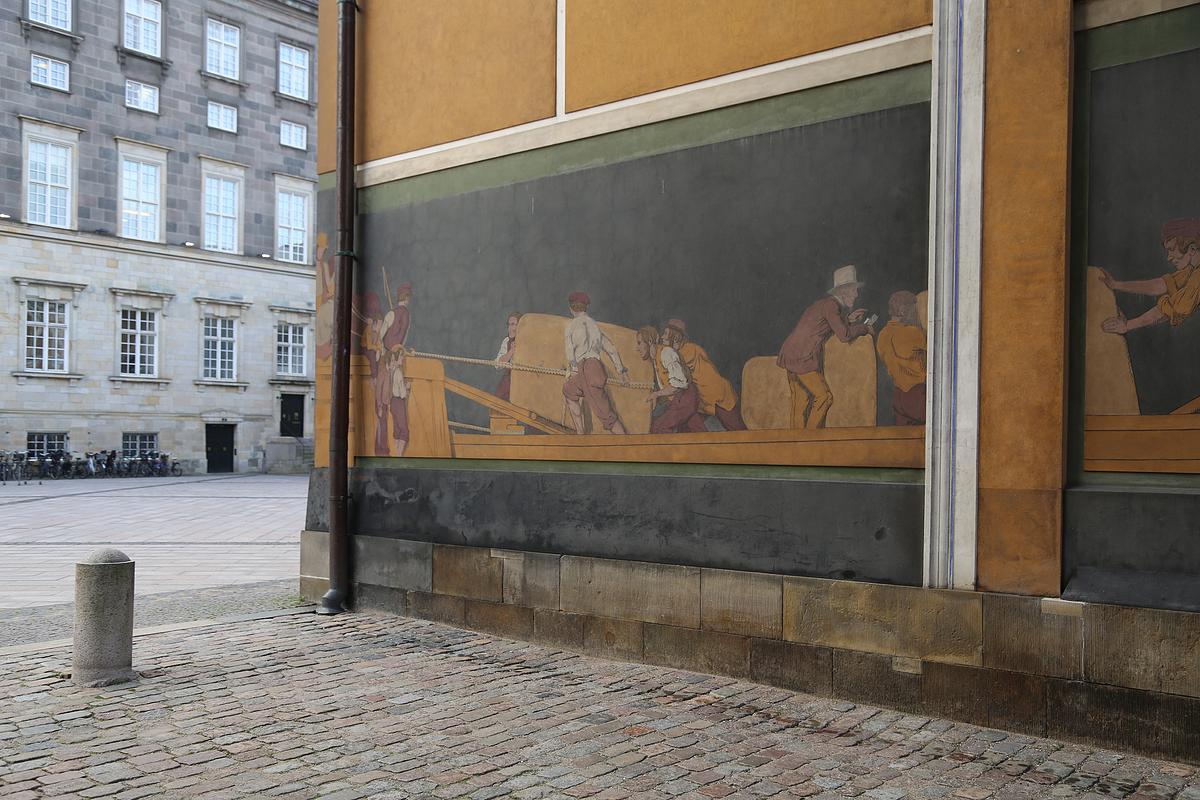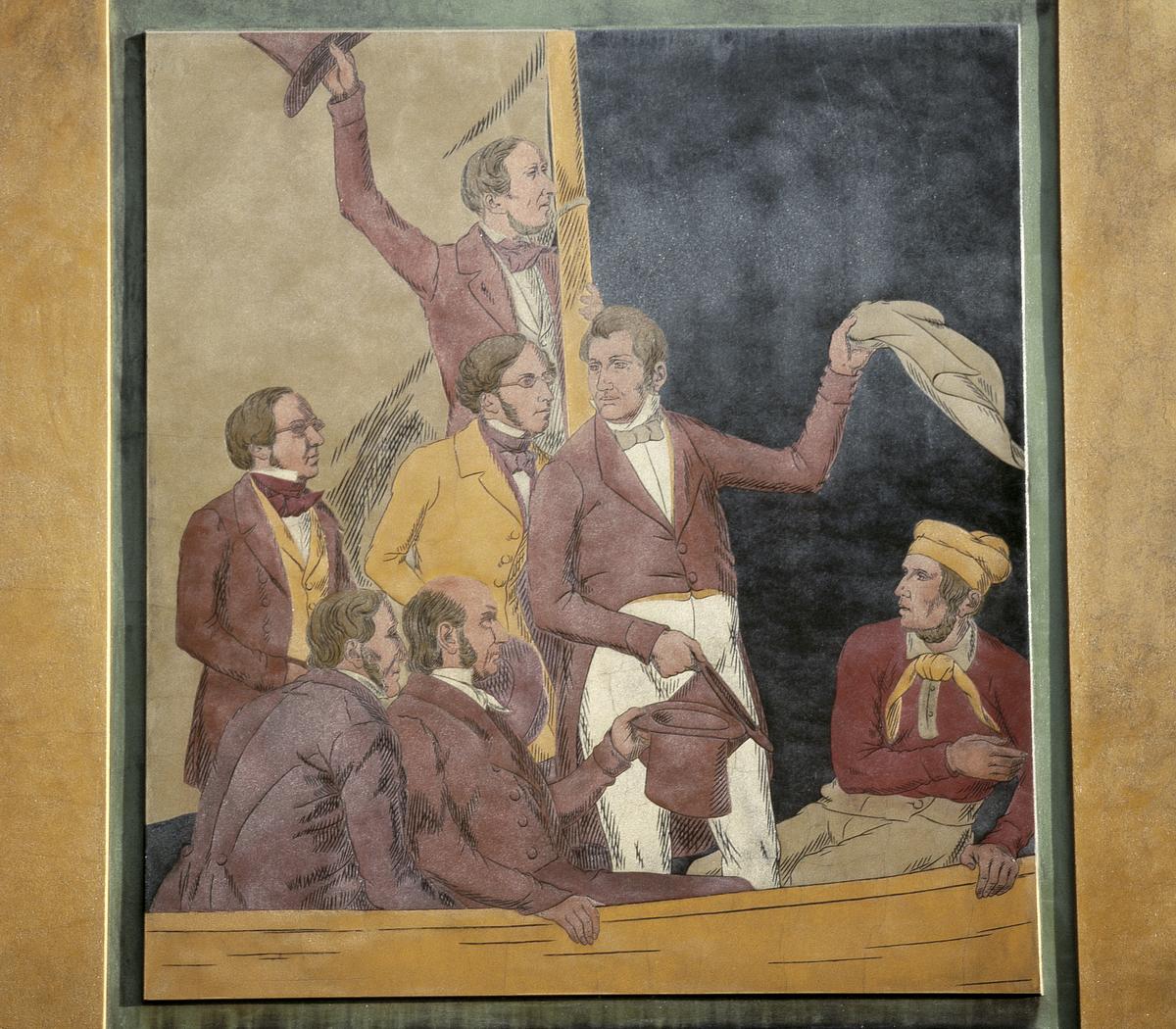
THE SONNE FRIEZE
The artistic frieze around the museum tells the story of Thorvaldsen's arrival back to Copenhagen and the story of the arrival of his sculptures in the museum.
In the frieze created for Thorvaldsens Museum by the Danish artist Jørgen Sonne, a historical scene is enacted to all who pass by the museum: The world-famous sculptor Bertel Thorvaldsen returned to Copenhagen in 1838 after many years spent in Rome, and he was received to scenes of great jubilation by a throng of Copenhagen citizens – both known and unknown, both old and young. The frieze is a colourful record of a time when the new middle classes in Denmark were in the ascendant and absolutism was nearing its end.
A man of the world comes home
In the middle of the afternoon of 17 September 1838, the frigate Rota appeared at the entrance to Copenhagen harbour. On board were Thorvaldsen, his collections of art and most of his own works. It is the frigate Rota that is the focal point of Sonne’s frieze. The ship occupies most of the façade facing Christiansborg Palace Chapel, and linked with it are two scenes, each on its own side of the museum building.
On the side facing the canal we see the official reception given to Thorvaldsen: small boats filled with people who have rowed out to receive him; someone has fallen into the water, the sailors are raising their oars in the captain’s sloop. Not least, there is the moment of going ashore – the moment when Thorvaldsen finally sets foot on Danish soil again.
On the side facing Christiansborg, on the other hand, there is a picture of the difficult task of transporting Thorvaldsen's works from the Rota right into the museum itself; huge packing cases and packages are being manhandled down from the ship, and gigantic statues are being lugged about with great difficulty.

Who is seen on the frieze?
The frieze shows some of the leading figures in the artistic and political life of the day, not least those who played a part in establishing Thorvaldsens Museum – both in 1838, when the scene is set, and also in the second half of the 1840s, when the frieze was created.
Historical inaccuracies and artistic licence
There is a host of historical inaccuracies and examples of artistic licence in the frieze. Sonne himself is seen sitting in a boat beside his brother, the engraver Edward Sonne, despite the fact that neither of them was there to witness the actual reception of Thorvaldsen on 17 September 1838. Sonne himself was still in Rome at that time. Similarly, Baroness Christine Stampe and her family occupy an entire boat in the arrival scene, but in reality they were not in town on the date in question. The Stampe family, however, played an important part in Thorvaldsen’s last six years in Denmark, and so they cannot be omitted from the gallery of personalities in the frieze.
And among those whom the frieze portrays as having been present at the event, there are more examples of persons who were not there. The art historian N.L. Høyen, for instance, and the painters Jørgen Roed, Constantin Hansen, Georg Hilker, Christen Købke and F.C. Krohn – all of whom can be seen in the artists’ boat – were all absent from the welcoming ceremony for Thorvaldsen on this important day. In the boat containing representatives of Copenhagen municipality, which is also included in the scene facing the canal, the politicians L.N. Hvidt and Orla Lehmann are right at the very front, although they had not yet become members of the city council in 1838. On the other hand, they had been elected by 1846-48, when the frieze was created, by which time they both were both playing an important part in the political efforts to introduce a democratic form of government in Denmark.
Poets and artists
There are more familiar faces to be seen in the crowd depicted in the frieze. Hans Christian Andersen is leaning against the mast in the “poets’ boat” and waving his hat. Andersen knew Thorvaldsen from his sojourns in Rome, where, as a member of the Danish artists’ colony, he had visited the sculptor and become a close friend. Also in the poets’ boat we can see N.F.S. Grundtvig and Adam Oehlenschläger, who often appeared among the circle of friends and acquaintances surrounding Thorvaldsen during his final years, both in Copenhagen and at the country mansion of Nysø near Præstø.
Just as the frieze contains the leading representatives of Danish literature, the visual arts are naturally also well represented. The painter C.W. Eckersberg and the sculptors Hermann Ernst Freund and Wilhelm Bissen are standing on land ready to receive Thorvaldsen. Both had worked closely with him in Rome. The same can be said of the high-ranking civil servant Jonas Collin, who was of major importance to Hans Christian Andersen and played an important part in efforts to establish the museum.

Sonne took his liberties
Sonne has also allowed his imagination free range in his reconstruction of the transport of Thorvaldsen’s works of art from the Rota to the museum. This is the part of the frieze that turns towards Christiansborg Palace. To begin with, the museum had simply not been built when Thorvaldsen returned to Copenhagen. The workers appearing in this part of the frieze were in reality portraits of artisans employed on building the museum in 1846-47, who were called in turn into the museum to sit for Sonne when he was making his sketches.
The frieze - unique in Danish art
Sonne’s frieze, which runs around three sides of Thorvaldsens Museum, is unique in Danish art in the way in which it combines the portrayal of a single moment – a specific historical event – with a political statement as it emphasises the emerging middle classes in Denmark. After the frieze had been created, the paintings in it were quite soon gradually spoiled by the elements, and in the 1950s the frieze was completely restored under the direction of the artist Axel Salto.
Since the 1950s, weather, wind and pollution have together severely damaged the frieze and the museum façades. So between 2001 and 2008, the façades were renovated, cleaned and consolidated. The undertaking was supported by Realdania and Copenhagen municipality.